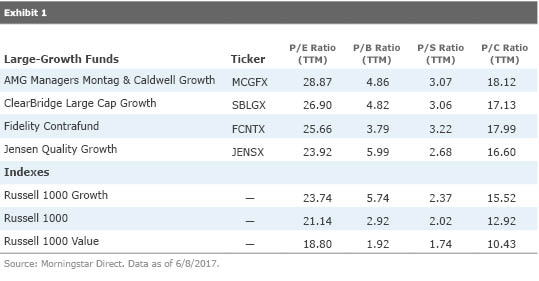Growth Funds May Be Riskier Than They Appear
Take backward-looking risk measures with a grain of salt.
The market has delivered a shot across the bow for growth stocks in recent days. Whether it's the beginning of a true correction for the stocks that have driven this current rally is anyone's guess. At the very least, it provides an opportunity to think about risk.
Last year I wrote about how no two bear markets are identical and how it's difficult to predict whether value or growth stocks will hold up better in the next one. Yet, somewhat surprisingly, growth stocks fared better than their value counterparts in each of the last three down markets (2007-09, 2011, and 2015-16).
Such impressive results can create a false sense of security for growth investors. Based on the past 10 years, a number of growth funds--large growth, in particular--look fairly low-risk. The Russell 1000 Growth Index had a loss (that is, downside) standard deviation of 11.97% over the last decade through May 2017 versus 12.72% for the Russell 1000 Value Index. Because growth stocks enjoyed much higher overall returns as well, they look even better on a risk-adjusted basis. The Russell 1000 Growth had a Sharpe ratio of 0.53 during that stretch versus 0.29 for the Russell 1000 Value.
Many large-growth funds that emphasize quality companies with high returns on capital and below-average debt levels did even better than the Russell 1000 Growth during these downturns. The four large-growth funds listed in the table below all have low or below-average Morningstar Risk ratings, which emphasize downside deviations in returns, over the trailing three, five, and 10 years. This is partly because they held up better than the overall market during the 2011 and 2015-16 downturns. They also tend to have fairly strong quality bona fides, too. For example, all four funds' portfolios have lower average debt/capital ratios than the Russell 1000 Growth.

This high-quality approach worked because investors fled to such companies during the past three sell-offs, and these funds generally didn't own what was punished most: companies with high debt in the 2007-09 credit crisis; financials (debt again) and materials during the 2011 Greek debt scare; and energy during the 2015-16 downturn driven by plummeting oil prices.
But their impressive results can make it easy to overlook the risks that may be lurking in many growth portfolios. The clearest risk in many cases is high average price multiples. In a U.S. market that's already trading at historically high multiples, large-growth stocks up the ante even more. As the table shows, these four funds all have average price multiples that are generally greater than those of the Russell 1000 Growth Index, which are well above those of the overall market to begin with.
The funds' high price multiples would most clearly become a liability in a valuation-driven bear market. Arguably, we haven't experienced one of those since the 2000-2003 bear market following the dot-com bubble. For those who believe in reversion to the mean, we may be due for one. But, again, there's no way of knowing whether this will be the case next time. As many have painfully discovered, price multiples tend to be poor timing indicators.
Past May Not Be Prologue Nevertheless, keep in mind that risk measures such as standard deviation and the Morningstar Risk rating are backward-looking. All they do is describe what happened in the past. They don't tell you anything about a fund's prospective risks. Recall that large-value funds and high-yield bond funds looked low-risk based on past performance right before the 2007-09 credit crisis.
Similarly, the danger today is that some investors may see high-quality companies--and the funds that own them--as synonymous with low risk. But high-quality companies can be just as vulnerable in a bear market, especially when they get expensive. That was the case with the Nifty Fifty stocks during the brutal bear market in the early 1970s.
So, stay focused on prospective risks and try to determine where they may lurk in your portfolio. As always, it's also a reminder to stay diversified, since what worked well during recent downturns may not necessarily work the next time around.

/s3.amazonaws.com/arc-authors/morningstar/e6b4cff4-0d77-4881-abc5-5b0b34d64bf6.jpg)
/cloudfront-us-east-1.images.arcpublishing.com/morningstar/HDPMMDGUA5CUHI254MRUHYEFWU.png)
/cloudfront-us-east-1.images.arcpublishing.com/morningstar/OMVK3XQEVFDRHGPHSQPIBDENQE.jpg)
:quality(80)/s3.amazonaws.com/arc-authors/morningstar/e6b4cff4-0d77-4881-abc5-5b0b34d64bf6.jpg)